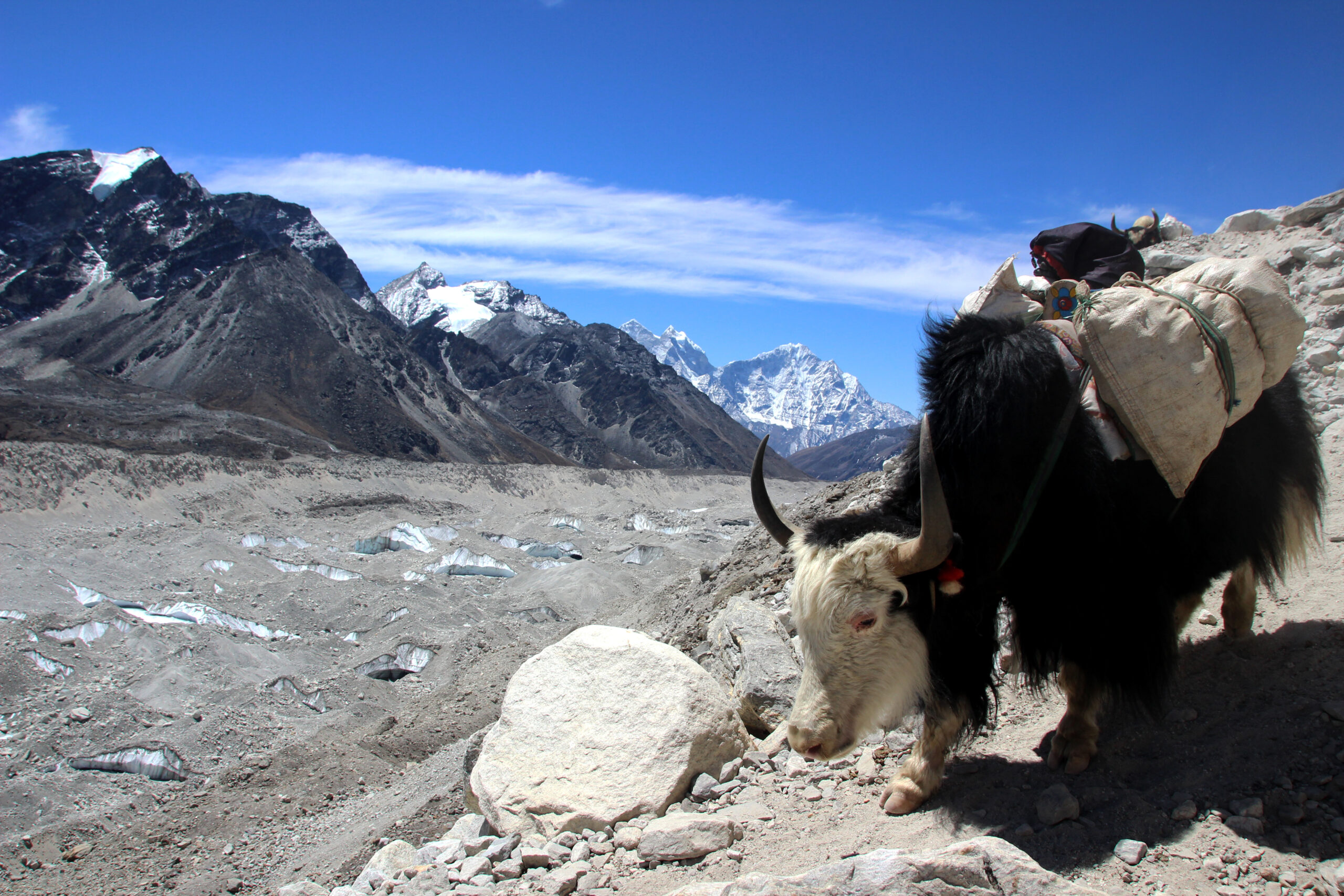
Sagarmatha National Park, a UNESCO World Heritage Site, is located in eastern Nepal within the breathtaking Himalayan range. Spanning an area of 443 square miles (1,148 sq km), this iconic destination is home to Mount Everest, the world’s tallest peak at 29,029 feet (8,848 m).
The park’s stunning landscapes include rugged terrain, deep gorges, and towering snow-capped mountains, making it a must-visit for adventurers and nature enthusiasts.
Top Attractions in Sagarmatha National Park
- Mount Everest: As the highest mountain on Earth, Mount Everest is the crown jewel of Sagarmatha National Park. It draws climbers, trekkers, and those seeking scenic flights for a bird’s-eye view of this natural wonder.
- Other Majestic Peaks: The park boasts several other peaks over 20,000 feet, including Amadablam, Cho Oyu, Lhotse, and Thamserku, all offering spectacular vistas.
- Scenic Landscapes: Visitors can experience rugged terrains, glacial valleys, and pristine Himalayan ecosystems.
Trekking and Mountaineering Opportunities
- Everest Base Camp Trek: A bucket-list adventure, this trek takes 12-14 days, including acclimatization stops, as you traverse high-altitude trails to the base of the world’s tallest mountain.
- Shorter Treks: Options include scenic routes to Namche Bazaar or Tengboche Monastery, perfect for those with limited time.
- Tips for Trekkers: High altitudes and challenging terrains make physical fitness and proper preparation essential. Always acclimatize and trek responsibly.
Wildlife and Vegetation
- Rare Wildlife: The park is home to elusive species like the snow leopard, red panda, and Himalayan wolf. Other inhabitants include Himalayan tahr, musk deer, and black bears.
- Birdwatching Haven: With 118 bird species, including the impeyan pheasant (Nepal’s national bird) and Himalayan griffon, the park is a paradise for bird lovers.
- Unique Vegetation: Forested areas feature bamboo, birch, rhododendron, and juniper. At higher altitudes, only lichens and mosses survive.
How to Reach Sagarmatha National Park
- By Air: The quickest option is to fly from Kathmandu to Lukla, followed by a trek into the park.
- By Road and Trekking:
- Take a bus from Kathmandu to Jiri, followed by a 10-day trek to Sagarmatha.
- Alternatively, take a bus to Salleri and trek for five days to reach the park.
- Getting Around: There is no public transportation within the park; all travel is done on foot.
Best Time to Visit Sagarmatha National Park
- October-November: Clear skies and ideal trekking conditions.
- March-May: Pleasant weather with blooming rhododendrons.
- December-February: Snowfall adds beauty, but temperatures drop significantly.
- June-September: Monsoon season brings heavy rains and slippery trails.
Sherpa Culture and Local Experiences
- Namche Bazaar: The vibrant gateway to Sagarmatha, offering markets, cafes, and cultural insights.
- Sherpa Hospitality: Experience the warmth and traditions of the Sherpa people.
- Festivals: Witness unique local celebrations like Mani Rimdu at Tengboche Monastery.
Tips for a Safe and Enjoyable Visit
- Acclimatize Properly: Avoid altitude sickness by taking regular rest days and staying hydrated.
- Pack Essentials: Bring warm clothing, sturdy boots, and trekking gear.
- Respect Nature: Follow park rules and practice eco-friendly trekking.
Conclusion
Sagarmatha National Park offers an unparalleled blend of natural beauty, cultural heritage, and thrilling adventure. Whether you’re trekking to Everest Base Camp, exploring Sherpa villages, or marveling at the park’s diverse wildlife, this Himalayan gem promises an unforgettable experience. Start planning your journey today to witness the awe-inspiring majesty of the world’s tallest peaks!
Explore the scenic Ama Yangri Trek.
Frequently Asked Questions
What is Sagarmatha National Park known for?
Sagarmatha National Park is famous for Mount Everest, the world’s tallest peak, and its breathtaking landscapes with rugged terrain and snow-capped mountains.
What are the best trekking routes in Sagarmatha National Park?
The Everest Base Camp Trek is the most popular, along with shorter treks to Namche Bazaar and Tengboche Monastery for stunning views and cultural experiences.
When is the best time to visit Sagarmatha National Park?
The best times are October-November for clear skies or March-May for mild weather and beautiful rhododendron blooms.
What wildlife can I see in Sagarmatha National Park?
The park is home to rare species like snow leopards, red pandas, Himalayan tahr, and various birds, including the national bird, impeyan pheasant.
How do I get to Sagarmatha National Park?
Fly to Lukla from Kathmandu and trek in, or take a bus to Jiri or Salleri and trek from there to reach the park.
DEX analytics platform with real-time trading data – https://sites.google.com/walletcryptoextension.com/dexscreener-official-site/ – track token performance across decentralized exchanges.
Privacy-focused Bitcoin wallet with coin mixing – https://sites.google.com/walletcryptoextension.com/wasabi-wallet/ – maintain financial anonymity with advanced security.
Lightweight Bitcoin client with fast sync – https://sites.google.com/walletcryptoextension.com/electrum-wallet/ – secure storage with cold wallet support.
Full Bitcoin node implementation – https://sites.google.com/walletcryptoextension.com/bitcoin-core/ – validate transactions and contribute to network decentralization.
Mobile DEX tracking application – https://sites.google.com/walletcryptoextension.com/dexscreener-official-site-app/ – monitor DeFi markets on the go.
Official DEX screener app suite – https://sites.google.com/mywalletcryptous.com/dexscreener-apps-official/ – access comprehensive analytics tools.
Multi-chain DEX aggregator platform – https://sites.google.com/mywalletcryptous.com/dexscreener-official-site/ – find optimal trading routes.
Non-custodial Solana wallet – https://sites.google.com/mywalletcryptous.com/solflare-wallet/ – manage SOL and SPL tokens with staking.
Interchain wallet for Cosmos ecosystem – https://sites.google.com/mywalletcryptous.com/keplr-wallet-extension/ – explore IBC-enabled blockchains.
Browser extension for Solana – https://sites.google.com/solflare-wallet.com/solflare-wallet-extension – connect to Solana dApps seamlessly.
Popular Solana wallet with NFT support – https://sites.google.com/phantom-solana-wallet.com/phantom-wallet – your gateway to Solana DeFi.
EVM-compatible wallet extension – https://sites.google.com/walletcryptoextension.com/rabby-wallet-extension – simplify multi-chain DeFi interactions.
All-in-one Web3 wallet from OKX – https://sites.google.com/okx-wallet-extension.com/okx-wallet/ – unified CeFi and DeFi experience.

Leave a Reply